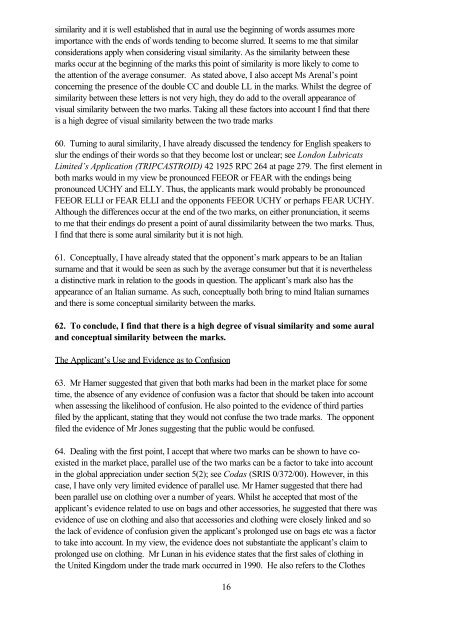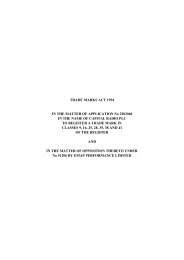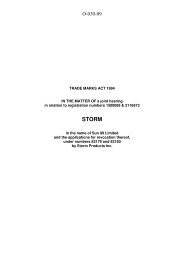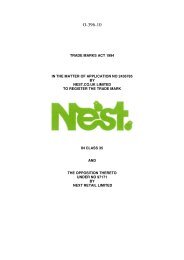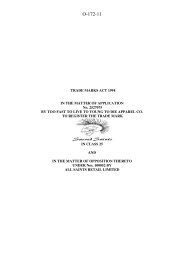Trade Mark Opposition Decision (O/509/02)
Trade Mark Opposition Decision (O/509/02)
Trade Mark Opposition Decision (O/509/02)
You also want an ePaper? Increase the reach of your titles
YUMPU automatically turns print PDFs into web optimized ePapers that Google loves.
similarity and it is well established that in aural use the beginning of words assumes more<br />
importance with the ends of words tending to become slurred. It seems to me that similar<br />
considerations apply when considering visual similarity. As the similarity between these<br />
marks occur at the beginning of the marks this point of similarity is more likely to come to<br />
the attention of the average consumer. As stated above, I also accept Ms Arenal’s point<br />
concerning the presence of the double CC and double LL in the marks. Whilst the degree of<br />
similarity between these letters is not very high, they do add to the overall appearance of<br />
visual similarity between the two marks. Taking all these factors into account I find that there<br />
is a high degree of visual similarity between the two trade marks<br />
60. Turning to aural similarity, I have already discussed the tendency for English speakers to<br />
slur the endings of their words so that they become lost or unclear; see London Lubricats<br />
Limited’s Application (TRIPCASTROID) 42 1925 RPC 264 at page 279. The first element in<br />
both marks would in my view be pronounced FEEOR or FEAR with the endings being<br />
pronounced UCHY and ELLY. Thus, the applicants mark would probably be pronounced<br />
FEEOR ELLI or FEAR ELLI and the opponents FEEOR UCHY or perhaps FEAR UCHY.<br />
Although the differences occur at the end of the two marks, on either pronunciation, it seems<br />
to me that their endings do present a point of aural dissimilarity between the two marks. Thus,<br />
I find that there is some aural similarity but it is not high.<br />
61. Conceptually, I have already stated that the opponent’s mark appears to be an Italian<br />
surname and that it would be seen as such by the average consumer but that it is nevertheless<br />
a distinctive mark in relation to the goods in question. The applicant’s mark also has the<br />
appearance of an Italian surname. As such, conceptually both bring to mind Italian surnames<br />
and there is some conceptual similarity between the marks.<br />
62. To conclude, I find that there is a high degree of visual similarity and some aural<br />
and conceptual similarity between the marks.<br />
The Applicant’s Use and Evidence as to Confusion<br />
63. Mr Hamer suggested that given that both marks had been in the market place for some<br />
time, the absence of any evidence of confusion was a factor that should be taken into account<br />
when assessing the likelihood of confusion. He also pointed to the evidence of third parties<br />
filed by the applicant, stating that they would not confuse the two trade marks. The opponent<br />
filed the evidence of Mr Jones suggesting that the public would be confused.<br />
64. Dealing with the first point, I accept that where two marks can be shown to have coexisted<br />
in the market place, parallel use of the two marks can be a factor to take into account<br />
in the global appreciation under section 5(2); see Codas (SRIS 0/372/00). However, in this<br />
case, I have only very limited evidence of parallel use. Mr Hamer suggested that there had<br />
been parallel use on clothing over a number of years. Whilst he accepted that most of the<br />
applicant’s evidence related to use on bags and other accessories, he suggested that there was<br />
evidence of use on clothing and also that accessories and clothing were closely linked and so<br />
the lack of evidence of confusion given the applicant’s prolonged use on bags etc was a factor<br />
to take into account. In my view, the evidence does not substantiate the applicant’s claim to<br />
prolonged use on clothing. Mr Lunan in his evidence states that the first sales of clothing in<br />
the United Kingdom under the trade mark occurred in 1990. He also refers to the Clothes<br />
16


